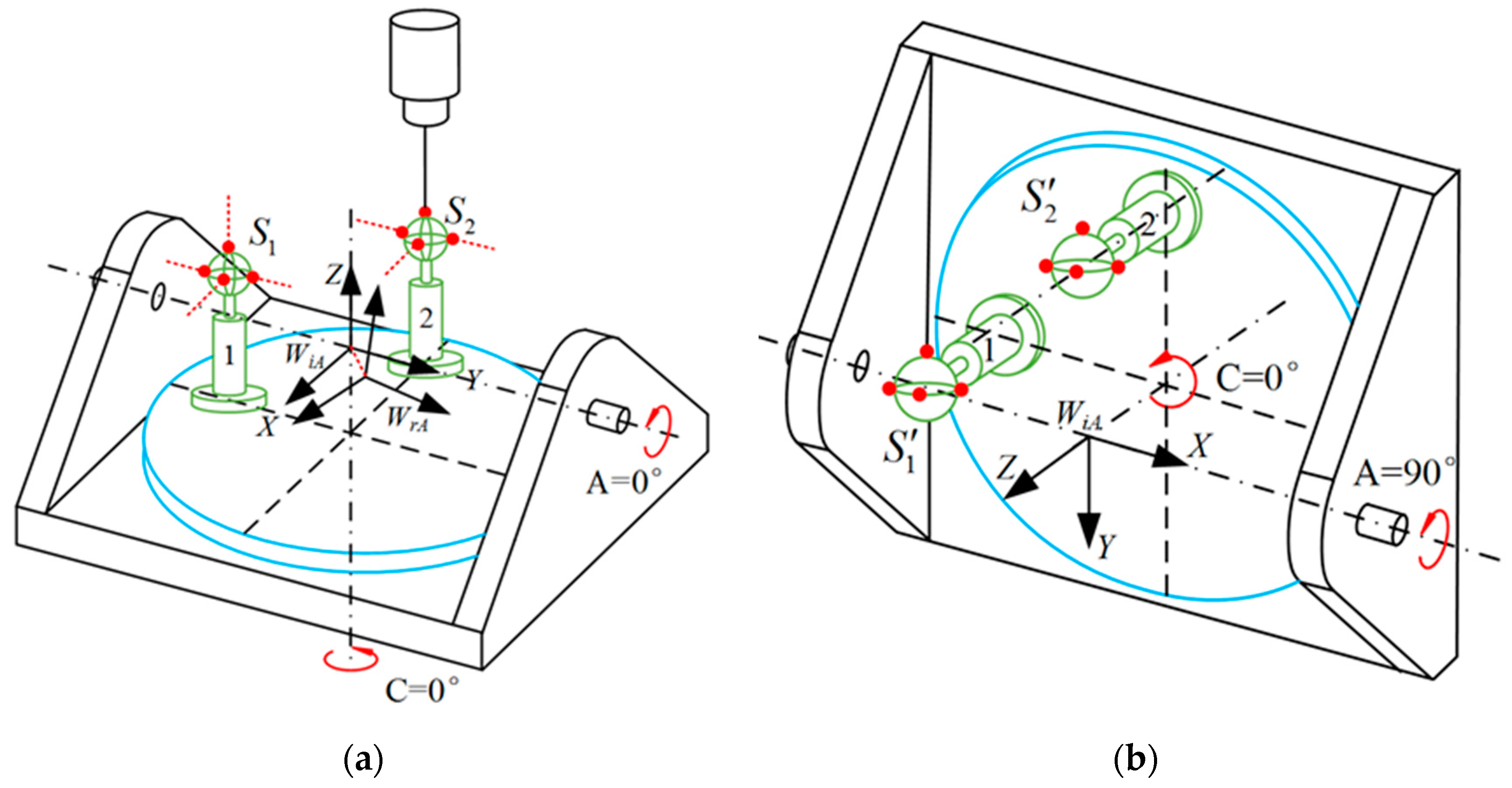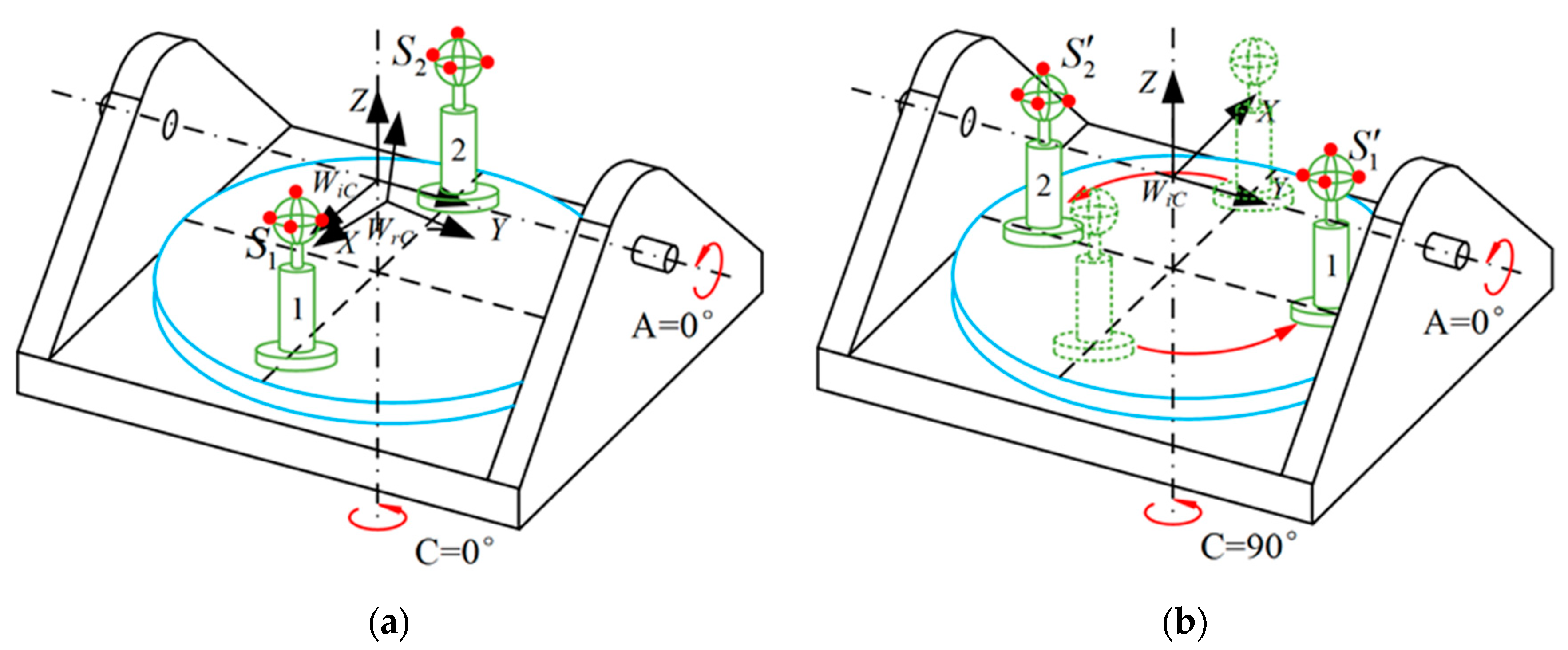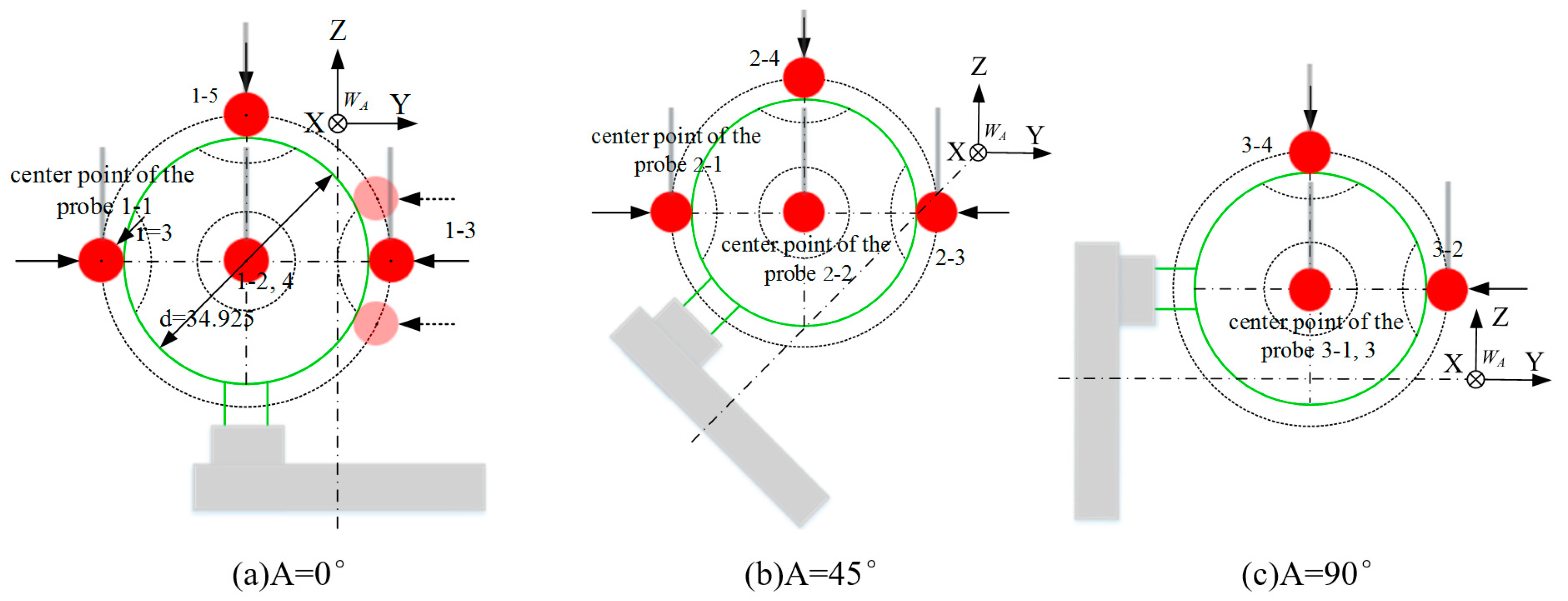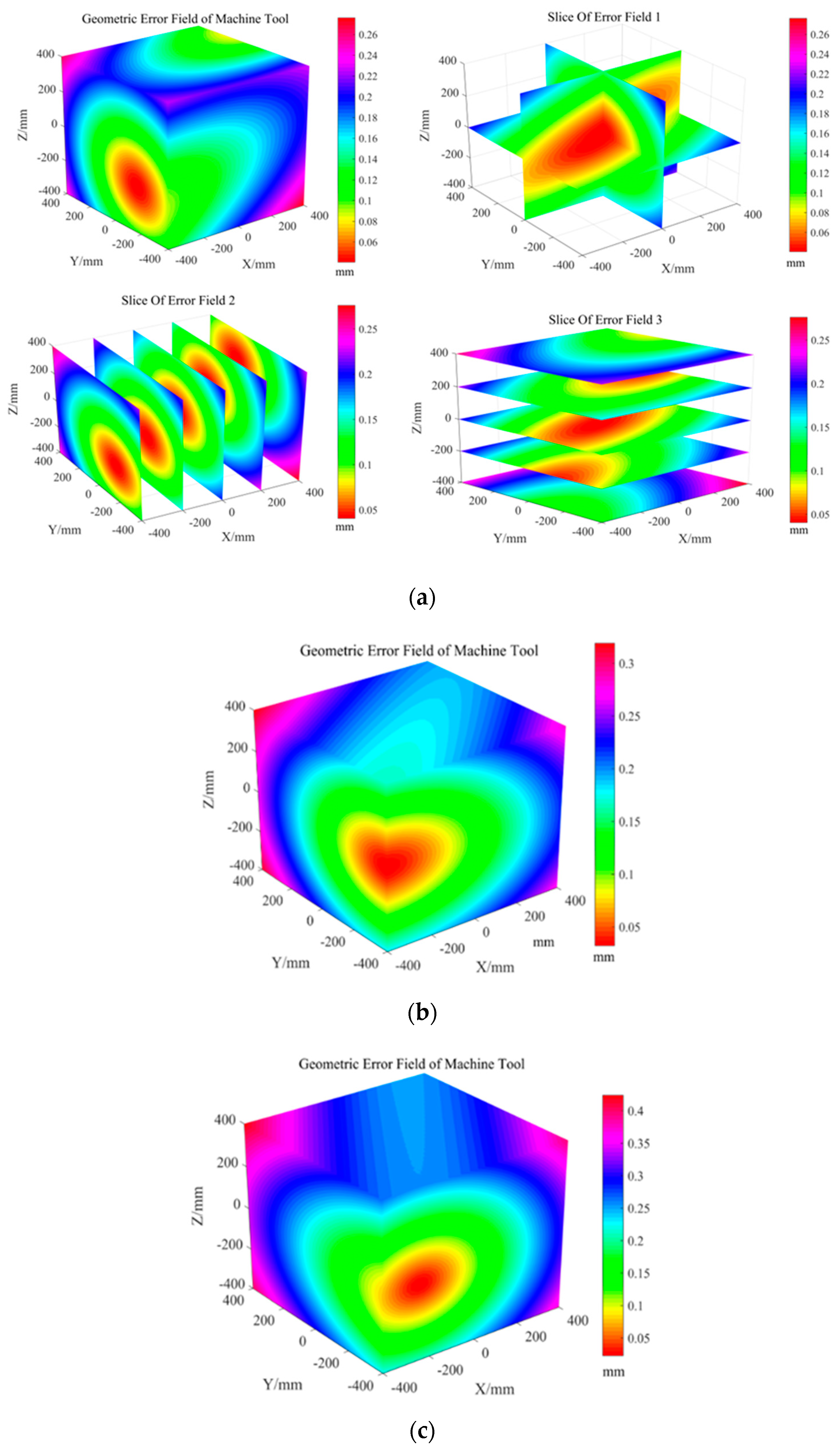Geometric Error Identification and Analysis of Rotary Axes on Five-Axis Machine Tool Based on Precision Balls
Abstract
:1. Introduction
2. Geometric Error of Five-axis CNC Machine Tool
2.1. Structure Analysis of Five-axis NC Machine Tool
2.2. Definition of Average Position Error of Rotary Axis
2.3. Establishment of Geometric Error Model of Rotary Axis
3. Identification of Position Error of Rotary Axis
3.1. Identification of Average Position Error of A-Axis
3.2. Identification of Average Position Error of C-Axis
4. Calibration and Analysis of Rotation Axis Position Error
4.1. In-Machine Measurement of the Center Point of Precision Ball Column
4.1.1. Multi-Degree of Freedom Step-by-Step Contact Scheme
4.1.2. On-Line Measurement of Spherical Detection Points
4.2. Analysis of Average Position Error of A and C Axes
4.3. Spatial Error Field Analysis of Five-Axis CNC Machine Tools
5. Validation Experiment
6. Conclusions
- (1)
- A model was developed for solving the average position errors of rotation A and C axes. Further, 10 average position errors of two rotating axes were obtained by bringing the coordinates of the center of spheres before and after 90° of rotation into the model.
- (2)
- An on-machine detection method was developed for average position errors of rotating axes based on the precision spherical column and a multi-degree of freedom, step-by-step contact scheme. The measurement accuracy obtained by this method was about 91.8% of traditional measurement equipment, such as laser interferometers and double-ball-bar measuring systems. However, the cost of the proposed method was about one tenth of the traditional methods and each test took about 20–30 min.
- (3)
- The spatial geometric error field of the five-axis CNC machine tool was determined based on the position errors of two identified rotating axes. By analyzing comprehensive error fields obtained by simulations, the following conclusions were drawn: (a) the comprehensive error of rotating spaces of A and C presented an increasing trend from inside to outside, (b) comprehensive error increased with the increase of the rotation angle of the A-axis, and therefore the large rotation angles of the A-axis had to be avoided, and (c) there was a machining space with less error in work center. By changing the A-axis angle of the table, the axis change of the optimal machining space had a certain offset law. These laws could provide guidance for error compensation, machining path, and parameter optimization, etc.
Author Contributions
Funding
Conflicts of Interest
References
- De Lacalle, L.N.L.; Lamikiz, A.; Munoa, J.; Salgado, M.A.; Sánchez, J.A. Improving the high-speed finishing of forming tools for advanced high-strength steels (ahss). Int. J. Adv. Manuf. Technol. 2006, 29, 49–63. [Google Scholar] [CrossRef]
- De Lacalle, L.N.L.; Lamikiz, A.; Sánchez, J.A.; de Bustos, I.F. Recording of real cutting forces along the milling of complex parts. Mechatronics 2006, 16, 21–32. [Google Scholar] [CrossRef]
- Guangming, S.; Gaiyun, H.; Dawei, Z.; Yicun, S.; Xiaolei, Z.; Bohui, D. Effects of geometrical errors of guideways on the repeatability of positioning of linear axes of machine tools. Int. J. Adv. Manuf. Technol. 2018, 98, 2319–2333. [Google Scholar]
- Lamikiz, A.; Lopez de Lacalle, L.N.; Sanchez, J.A.; Bravo, U. Calculation of the specific cutting coefficients and geometrical aspects in sculptured surface machining. Mach. Sci. Technol. 2006, 9, 411–436. [Google Scholar] [CrossRef]
- Hale, L.C. Principles and techniques for designing precision machines. Ph.D. Thesis, Massachusetts Institute of Technology, Ann Arbor, MA, USA, 1999. [Google Scholar]
- Mayr, J.; Jedrzejewski, J.; Uhlmann, E.; Donmez, M.A.; Knapp, W.; Hartig, F.; Wendt, K.; Moriwaki, T.; Shore, P.; Schmitt, R. Thermal issues in machine tools. CIRP Ann. Manuf. Tech. 2012, 61, 771–791. [Google Scholar] [CrossRef] [Green Version]
- Olvera, D.; de Lacalle, L.N.L.; Compeán, F.I.; Fz-Valdivielso, A.; Lamikiz, A.; Campa, F.J. Analysis of the tool tip radial stiffness of turn-milling centers. Int. J. Adv. Manuf. Technol. 2012, 60, 883–891. [Google Scholar] [CrossRef]
- Hsieh, T.; Chen, P.; Jywe, W.; Chen, G.; Wang, M. A Geometric Error Measurement System for Linear Guideway Assembly and Calibration. Appl. Sci. 2019, 9, 574. [Google Scholar] [CrossRef] [Green Version]
- Li, X.; Yang, X.; Gao, L.; Su, Z.; Wei, X.; Lv, Z. Rapid Measurement and Identification Method for the Geometric Errors of CNC Machine Tools. Appl. Sci. 2019, 9, 2701. [Google Scholar] [CrossRef] [Green Version]
- Kiridena, V.; Ferreira, P.M. Mapping the effects of positioning errors on the volumetric accuracy of five-axis cnc machine tools. Int. J. Mach. Tools Manuf. 1993, 33, 417–437. [Google Scholar] [CrossRef]
- Srivastava, A.K.; Veldhuis, S.C.; Elbestawit, M.A. Modelling geometric and thermal error in a five-axis cnc machine tool. Int. J. Mach. Tools Manuf. 1995, 35, 1321–1337. [Google Scholar] [CrossRef]
- Lin, Y.; Shen, Y. Modelling of five-axis machine tool metrology models using the matrix summation approach. Int. J. Adv. Manuf. Technol. 2003, 21, 243–248. [Google Scholar]
- Lamikiz, A.; López de Lacalle, L.N.; Ocerin, O.; Díez, D.; Maidagan, E. The Denavit and Hartenberg approach applied to evaluate the consequences in the tool tip position of geometrical errors in five-axis milling centres. Int. J. Adv. Manuf. Technol. 2008, 37, 122–139. [Google Scholar] [CrossRef]
- Chen, G.S.; Mei, X.S.; Li, H.L. Geometric error modeling and compensation for large-scale grinding machine tools with multi-axes. Int. J. Adv. Manuf. Technol. 2013, 69, 2583–2592. [Google Scholar] [CrossRef]
- Díaz-Tena, E.; Ugalde, U.; López de Lacalle, L.N.; de la Iglesia, A.; Calleja, A.; Campa, F.J. Propagation of assembly errors in multitasking machines by the homogenous matrix method. Int. J. Adv. Manuf. Technol. 2013, 68, 149–164. [Google Scholar] [CrossRef]
- Fu, G.; Fu, J.; Gao, H.; Yao, X. Squareness error modeling for multi-axis machine tools via synthesizing the motion of the axes. Int. J. Adv. Manuf. Technol. 2017, 89, 1–16. [Google Scholar] [CrossRef]
- Lee, K.; Lee, D.M.; Yang, S.H. Parametric modeling and estimation of geometric errors for a rotary axis using double ball-bar. Int. J. Adv. Manuf. Technol. 2012, 62, 741–750. [Google Scholar] [CrossRef]
- Xiang, S.T.; Yusuf, A. Modeling and compensation of volumetric errors for five-axis machine tools. Int. J. Mach. Tools Manuf. 2016, 101, 65–78. [Google Scholar] [CrossRef]
- Chen, Y.T.; Lin, W.C.; Liu, C.S. Design and experimental verification of novel six-degree-of freedom geometric error measurement system for linear stage. Opt. Lasers Eng. 2017, 92, 94–104. [Google Scholar] [CrossRef]
- Qibo, F.; Bin, Z.; Cunxing, C.; Cuifang, K.; Yusheng, Z.; Fenglin, Y. Development of a simple system for simultaneously measuring 6DOF geometric motion errors of a linear guide. Opt. Express. 2013, 21, 25805. [Google Scholar] [CrossRef]
- Liu, H.; Xiang, H.; Chen, J.; Yang, R. Measurement and compensation of machine tool geometry error based on Abbe principle. Int. J. Adv. Manuf. Technol 2008. published online. [Google Scholar] [CrossRef]
- Mutilba, U.; Gomez-Acedo, E.; Sandá, A.; Vega, I.; Yagüe-Fabra, J.A. Uncertainty assessment for on-machine tool measurement: An alternative approach to the ISO 15530-3 technical specification. Precis. Eng. 2019, 57, 45–53. [Google Scholar] [CrossRef] [Green Version]
- Linares, J.; Chaves-Jacob, J.; Schwenke, H.; Longstaff, A.; Fletcher, J.; Uhlmann, E.; Wintering, J. Impact of measurement procedure when error mapping and compensating a small CNC machine using a multilateration laser interferometer. Precis. Eng. 2014, 38, 578–588. [Google Scholar] [CrossRef]
- Ibaraki, S.; Nagae, K.; Sato, G. “open-loop” tracking interferometer for machine tool volumetric error measurement. CIRP Ann.-Manuf. Technol 2014, 63, 501–504. [Google Scholar] [CrossRef] [Green Version]
- GGomez-Acedo, E.; Olarra, A.; Zubieta, M.; Kortaberria, G.; Ariznabarreta, E.; López de Lacalle, L.N. Method for measuring thermal distortion in large machine tools by means of laser multilateration. Int. J. Adv. Manuf. Technol. 2015, 80, 523–534. [Google Scholar] [CrossRef]
- GGomez-Acedo, E.; Olarra, A.; Orive, J.; Lopez de la Calle, L.N. Methodology for the design of a thermal distortion compensation for large machine tools based in state-space representation with Kalman filter. Int. J. Mach. Tools Manuf. 2013, 75, 100–108. [Google Scholar] [CrossRef]
- Lei, W.T.; Hsu, Y.Y. Error measurement of five-axis cnc machines with 3d probe–ball. J. Mater. Process. Tech. 2003, 139, 127–133. [Google Scholar] [CrossRef]
- Lee, K.I.; Yang, S.H. Measurement and verification of position-independent geometric errors of a five-axis machine tool using a double ball-bar. Int. J. Mach. Tools Manuf. 2013, 70, 45–52. [Google Scholar] [CrossRef]
- Zhang, Y.; Yang, J.; Zhang, K. Geometric error measurement and compensation for the rotary table of five-axis machine tool with double ball bar. Int. J. Adv. Manuf. Technol. 2013, 65, 275–281. [Google Scholar] [CrossRef]
- Weikert, S. R-test a new device for accuracy measurements on five axis machine tools. CIRP Ann. Manuf. Technol. 2004, 53, 429–432. [Google Scholar] [CrossRef]
- Hong, C.; Ibaraki, S.; Oyama, C. Graphical presentation of error motions of rotary axes on a five-axis machine tool by static R-test with separating the influence of squareness errors of linear axes. Int. J. Mach. Tools Manuf. 2012, 59, 24–33. [Google Scholar] [CrossRef]
- Ibaraki, S.; Iritani, T.; Matsushita, T. Error map construction for rotary axes on five-axis machine tools by on-the-machine measurement using a touch-trigger probe. Int. J. Mach. Tools Manuf. 2013, 68, 21–29. [Google Scholar] [CrossRef] [Green Version]
- Jiang, Z.; Song, B.; Zhou, X.; Tang, X.; Zheng, S. On-machine measurement of location errors on five-axis machine tools by machining tests and a laser displacement sensor. Int. J. Mach. Tools Manuf. 2015, 95, 1–12. [Google Scholar] [CrossRef]
- Jeong, J.H.; Khim, G.; Oh, J.S.; Chung, S.C. Method for measuring location errors using a touch trigger probe on four-axis machine tools. Int. J. Adv. Manuf. Technol. 2018, 99, 1003–1012. [Google Scholar] [CrossRef]
- Chen, Y.T.; More, P.; Liu, C.S. Identification and verification of location errors of rotary axes on five-axis machine tools by using a touch-trigger probe and a sphere. Int. J. Adv. Manuf. Technol. 2019, 100, 2653–2667. [Google Scholar] [CrossRef]
- International Organization for Standardization. ISO 230-7: 2006. Test Code for Machine Tools-Part 7: Geometric Accuracy of Axes of Rotation; ISO: Geneva, Switzerland, 2006. [Google Scholar]
- Ibaraki, S.; Knapp, W. Indirect measurement of volumetric accuracy for three-axis and five-axis machine tools: A review. Int. J. Autom. Technol. 2012, 6, 110–124. [Google Scholar] [CrossRef] [Green Version]








| Error Symbol | Definition |
|---|---|
| Average angle positioning error of A-axis | |
| Average angle error of A-axis rotating around Y-axis | |
| Average angle error of A-axis rotating around Z-axis | |
| Average line error of A-axis along X direction | |
| Average line error of A-axis along Y direction | |
| Average line error of A-axis along Z direction | |
| Average angle error of C-axis around X direction at | |
| Average angle error of C-axis around Y direction at | |
| Average angle error of C-axis around Z direction at | |
| Average line error of C-axis along X direction at | |
| Average line error of C-axis along Y direction at | |
| Average line error of C-axis along Z direction at |
| The Technical Requirements | Parameters |
|---|---|
| External dimension of the Probe | Diameter: Φ55 mm, length:95 mm |
| Standard probe length | 60 mm |
| Direction of measurement | ±X, ±Y, −Z |
| Unidirectional repeat accuracy of the Probe | 0.001 mm (2σ) |
| The maximum Angle of swing of the probe in the XY plane | 15° |
| Position of A/C Axes | A = −30° | A = 0° | A = 45° | A = 90° | C = 0° | C = 90° | C = 180° | C = 270° | ||
|---|---|---|---|---|---|---|---|---|---|---|
| Precision ball column 1 | +X direction | X | −542.852 | −542.558 | −542.838 | −543.228 | −542.558 | −349.362 | −82.458 | −276.223 |
| Y | 279.061 | −248.368 | −194.373 | −151.346 | −248.368 | 14.301 | −178.918 | −445.515 | ||
| Z | −152.402 | −124.420 | −117.968 | −155.992 | −124.420 | −127.283 | −125.500 | −126.748 | ||
| +Y direction | X | −522.888 | −522.478 | −522.650 | — | −522.478 | −329.562 | −63.072 | — | |
| Y | −297.603 | −270.640 | −215.393 | −270.640 | −4.267 | −197.653 | ||||
| Z | −152.402 | −124.419 | −117.968 | −124.419 | −127.283 | −125.500 | ||||
| −X direction | X | −502.606 | −502.948 | −502.627 | −502.706 | −502.948 | −308.803 | −42.241 | −235.750 | |
| Y | −276.389 | −253.204 | −195.493 | −151.723 | −253.204 | 16.877 | −176.624 | −446.369 | ||
| Z | −152.403 | −124.419 | −117.968 | −155.992 | −124.419 | −127.283 | −125.500 | −126.748 | ||
| −Z direction | X | −523.182 | −522.553 | −521.928 | −523.408 | −522.553 | −329.052 | −62.126 | −255.644 | |
| Y | −278.313 | −249.902 | −193.589 | −151.722 | −249.902 | 15.898 | −176.594 | −446.370 | ||
| Z | −135.031 | −108.214 | −101.017 | −137.995 | −108.214 | −108.300 | −108.273 | −108.225 | ||
| Precision ball column 2 | +X direction | X | −356.170 | −356.154 | −356.159 | — | −356.154 | −92.175 | −264.277 | −528.390 |
| Y | −35.644 | 4.713 | −42.591 | 4.713 | −167.813 | −430.469 | −259.742 | |||
| Z | −61.554 | −167.678 | −328.667 | −167.678 | −166.801 | −167.099 | −168.327 | |||
| +Y direction | X | −338.678 | −338.865 | −339.574 | — | −338.865 | −75.173 | −247.467 | −510.274 | |
| Y | −53.944 | −13.060 | −62.417 | −13.060 | −185.877 | −449.819 | −277.854 | |||
| Z | −61.554 | −164.275 | −328.668 | −164.275 | −166.801 | −167.098 | −168.327 | |||
| −Z direction | X | −338.456 | −338.329 | −338.167 | — | −338.329 | −74.133 | −245.692 | −510.694 | |
| Y | −36.674 | 4.939 | −42.401 | 4.939 | −168.983 | −413.539 | −261.123 | |||
| Z | −46.147 | −152.235 | −312.895 | −152.235 | −152.182 | −152.071 | −152.152 | |||
| Position Error (μm) | ||||||||||
|---|---|---|---|---|---|---|---|---|---|---|
| Precision balls method | 10.6 | −19.4 | 29.8 | 25.7 | −15.1 | 13.7 | 23.9 | −18.5 | −21.3 | 28.2 |
| Chen’s method | 12.7 | −20.1 | 27.6 | 24.0 | −12.3 | 15.6 | 22.4 | −18.4 | −19.8 | 27.2 |
| A and C axis Accuracy Comparison | 89.5% | 94.1% | ||||||||
© 2019 by the authors. Licensee MDPI, Basel, Switzerland. This article is an open access article distributed under the terms and conditions of the Creative Commons Attribution (CC BY) license (http://creativecommons.org/licenses/by/4.0/).
Share and Cite
Li, C.; Liu, X.; Li, R.; Wu, S.; Song, H. Geometric Error Identification and Analysis of Rotary Axes on Five-Axis Machine Tool Based on Precision Balls. Appl. Sci. 2020, 10, 100. https://doi.org/10.3390/app10010100
Li C, Liu X, Li R, Wu S, Song H. Geometric Error Identification and Analysis of Rotary Axes on Five-Axis Machine Tool Based on Precision Balls. Applied Sciences. 2020; 10(1):100. https://doi.org/10.3390/app10010100
Chicago/Turabian StyleLi, Chuandong, Xianli Liu, Rongyi Li, Shi Wu, and Houwang Song. 2020. "Geometric Error Identification and Analysis of Rotary Axes on Five-Axis Machine Tool Based on Precision Balls" Applied Sciences 10, no. 1: 100. https://doi.org/10.3390/app10010100




